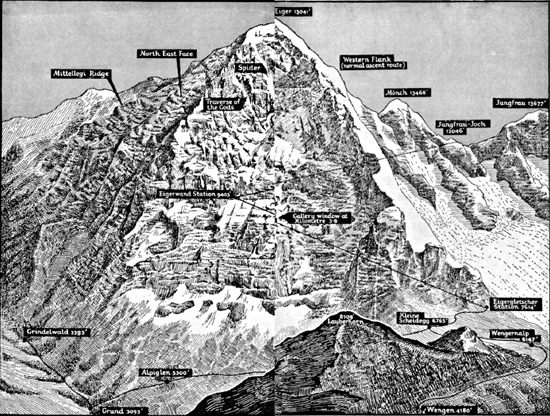
Полная версия:
The White Spider

Heinrich Harrer
The White Spider
THE STORY OF
THE NORTH FACE OF THE EIGER
Translated from the German by
HUGH MERRICK
With additional chapters by
HEINRICH HARRER AND KURT MAIX
With an Introduction by
JOE SIMPSON


William Collins
An imprint of HarperCollinsPublishers Ltd. 1 London Bridge Street London SE1 9GF
www.harpercollins.co.uk
This edition published by Harper Perennial 2005
Previously published in paperback by Flamingo 1995
Previously published in paperback by Paladin 1989
First published in Great Britain by Rupert Hart-Davis Ltd 1959
Revised edition 1965
Second revised edition published by Granada Publishing 1976
Copyright © Heinrich Harrer 1958, 1964
This translation copyright © Rupert Hart-Davis Ltd 1959
Introduction copyright © Joe Simpson 2005
PS section copyright © Miranda Haines 2005
PS™ is a trademark of HarperCollinsPublishers Ltd.
Heinrich Harrer asserts the moral right to be identified as the author of this work
A catalogue record for this book is available from the British Library
All rights reserved under International and Pan-American Copyright Conventions. By payment of the required fees, you have been granted the nonexclusive, nontransferable right to access and read the text of this ebook on-screen. No part of this text may be reproduced, transmitted, downloaded, decompiled, reverse-engineered, or stored in or introduced into any information storage and retrieval system, in any form or by any means, whether electronic or mechanical, now known or hereinafter invented, without the express written permission of HarperCollins ebooks
HarperCollinsPublishers has made every reasonable effort to ensure that any picture content and written in this ebook has been included or removed in accordance with the contractual and technological constraints in operation at the time of publication
Source ISBN: 9780007197842
Ebook Edition © SEPTEMBER 2010 ISBN: 9780007347575
Version: 2017-04-27
Contents
Title page
Copyright
Introduction
Map
“Come back safe, my friends”
The “White Spider”
The First Attempt on the North Face
The Tragedy of Toni Kurz
1937 on the Eiger
The First Ascent of the Face
Further Successful Ascents
1952: The Great Year on the Eiger
The Wall of Life and Death
The Tragedy of 1957
The International Rescue Team
Epilogue
Fate made the Amendments
Four Shirts and an Overcoat
Ascendancy of the Armchair
The Silver Trench
Climbers have a Language of their own
“I am sorry, Brian …”
July 31st: Start and Finish
The Mass Assault
The Year of Chivalry
Man, the Deciding Factor
Route Guide to the North Face
Attempts and Successes on the North Face
Keep Reading
Index
About the Author
P. S. Ideas, interviews & features …
About the author
Heinrich Harrer: An Extraordinary Life
Life at a Glance
Harrer’s Top Tips to Modern Explorers
Read on
If You Loved This, You Might Like …
Have You Read?
Find Out More
Also by the Author
About the Publisher
Introduction
The North Face of the Eiger has always held a lingering fascination for me from the moment I finished reading Heinrich Harrer’s The White Spider at the age of fourteen. This gripping account of the first ascent in 1938 and the subsequent and often disastrous attempts that followed should really have put me off mountaineering for life. Only a week earlier I had been taken rock climbing on a small limestone crag on the edge of the North York Moors. I was unaware that the arcane world of extreme mountaineering even existed, let alone considered devoting the rest of my life to it. When I closed the book, my head was filled with grim black-and-white images of men fighting for survival in a ferociously steep and unrelentingly dangerous landscape. I could not imagine any more frightening way to die. Avalanches, rock falls crashing past like gun shots, lightning blasting through storm-lashed days, men pinned down unable to escape, dying slowly before the horrified gaze of tourist onlookers in the valley below - why would anyone want to place themselves in such a nightmarish situation? I had no idea, so I read the book again.
I was no better informed at the end of the second reading, but I knew one thing: I wanted to find out. Despite the terrible hardship and awful deaths, I was forcibly struck by the fact that these men had chosen to be there. They couldn’t all be idiots. There must be something very special about mountaineering for these people to think that such risks are worth it. I became a mountaineer inspired by the most gripping and frightening mountaineering book I have ever read.
Eleven years later, much to my chagrin, I found myself hanging helplessly from a rope, battered by avalanches and storm winds, badly injured, and about to plunge into a nightmare every bit as bad as those described in The White Spider. Today, thirty years after reading Harrer’s book, I am astounded by the number of young people who tell me that my account of this survival epic in Peru, Touching the Void, inspired them to take up climbing. It is some consolation to know that my rather odd decision-making processes as a fourteen-year-old are being replicated today.
In many ways The White Spider is an unlikely success. The language can seem archaic and incongruous today. The grainy black-and-white photographs seem old-fashioned compared to the sumptuous photography in modern mountaineering literature. Today, standards of climbing have far outstripped anything that would be found on the 1938 route. It should really be a relic of mountaineering history accessible only to the most avid of climbing aficionados. And yet it is these very criticisms that make it such a fascinating and seminal book.
It is not solely about mountaineering. It is about humanity, courage, strength in adversity, and the power of the mind. It is impossible to read this book without being awed by the single-minded determination of a small band of poorly equipped climbers struggling to survive in a world that few of us can imagine. It is also impossible not to ask why they chose to do such a thing. Unfortunately the only way to understand the answer to that question is by going and doing it yourself. A climber would never ask such a question, and a non-climber would never understand the answer.
When I read of Toni Kurz enduring such a terrible, drawn-out death, hanging alone on a rope, his companions dead around him, his rescuers tantalizingly out of reach, I was horrified and fascinated in equal measure. This, I was later to discover, is the essence of mountaineering: that strange mixture of fear and excitement, the addiction of apprehension and anticipation without which mountaineering would simply be another sport. It is far, far more than sport. It is not done to win a game, to gain a gold medal, to beat a fellow competitor. It is a nonsensical game of life, and it is this absurd pointlessness that makes it so addictive. If death were not ever present many would not be drawn to it. Death, in a paradoxical way, validates the life-affirming nature of the game played. It becomes, in the end, a lifestyle rather than a sport; a game of risk in which what you stand to lose far outweighs whatever you could possibly win. After many years I finally understood what Toni Kurz thought was worth dying for, and yet I could never describe it properly to others. That in itself was reason enough to do it.
The White Spider is at once the most exciting and compulsively gripping of books and at the same time repellent and disturbing. Heroic in scale, legendary in the stories of long-lost lives that it recounts, it allows readers to experience vicariously the terror and the exultation of mountaineering from the warm comfort of their armchairs. It leaves you with a haunted sense of wonder. As you close the book you are confused by the life-enhancing delight of climbing that shines through stories of the most appalling human experiences. It leaves you filled with apprehension and wondering what it would be like to be up there on the forbidding fastness of that storm-lashed face.
Harrer writes about the aura of fatality of the Eiger’s North Face and of the ‘hunted’ feeling that climbers experience on the climb. The grim history lies scattered all around. Broken pitons, the shattered rocks strewn with the debris of past ascents, torn rucksacks, tattered ropes drifting in the wind, indistinguishable scraps of colour-drained clothing, the unshakable sense of other people’s tragedies found in lonely spots all over the face. I had always been haunted by the North Face of the Eiger.
In September 2000, when Ray Delaney and I made our first attempt on the 1938 route, it was less a climb and more a pilgrimage in the footsteps of our heroes. It was exciting and frightening and loaded with the psychological baggage of all that we knew about it. We too felt that hunted sensation as we mutely witnessed the deaths of two young men, then crept, cowed and haunted, back to the safety of the valley. We tried again during the following two summers, beaten back each time by foul weather and cold, uncomfortable bivouacs. Today we still think about returning to this seminal mountain to complete our farewell ascent to a lifetime of mountaineering that was inspired, for me at least, almost entirely by reading The White Spider.
One successful ascensionist described his time on the face: ‘I seemed to have been in a dreamland; not a dreamland of rich enjoyment, but a much more beautiful land where burning desires were translated into deeds.’ That to me was inspirational. The words of an intelligent, sensitive man who had ‘in complete harmony … a perfectly fashioned body, a bright, courageous mind and a receptive spirit’. A man who thought that sometimes in life it was worth gambling far more than you could ever possibly win.
Joe Simpson
Sheffield
September 2004
Joe Simpson is the author of Touching the Void and The Beckoning Silence.
Map

“Come back safe, my friends”
“WRITING a book about the North Face of the Eiger? Whatever for?” The question was put to me by a man of some standing in Alpine circles. I was taken aback and slightly cross, so I gave him a somewhat off-hand answer: “For people to read, of course.”
That started him off on a passionate tirade.
“Who’s likely to read it? Don’t you think the handful of climbers who are really interested in that crazy venture have had quite enough literature on the subject already? Or do you just want to join the sensation-mongers, from whose ranks a serious climber like yourself should keep as remote as possible?”
I answered him: “If all climbers shared your point of view, it wouldn’t be surprising to find the newspaper reports overflowing with misstatements and exaggerations. I believe the public has a right to authoritative information, especially when mountaineering problems become human ones. And I think it is a climber’s duty to contribute to the formation of public opinion in such matters.”
And with that I dropped the unpleasant argument.
However, he had failed to shake my purpose to write a book about the Eiger. I had already been engaged on the preliminary work for months, indeed for years. My home was piled high with books, periodicals, newspaper-cuttings—about two thousand of them in various languages—on the subject of the Eiger’s North Face. I had written, and received replies to, innumerable letters. Every letter from a climber who had actually done the North Face was a personal document and, more than that, the documentation of a personality. I had no intention of allowing the History of the Eiger’s North Face to become a mere calendar of climbs, its foreground theme was to be the men who had done those climbs.
This man, who was so shocked at the idea of my writing a book about the North Face of the Eiger, was akin to a certain type of climber, who plants himself on a pedestal of extreme exaltation and merely smiles superciliously at the nonsensical idea of writing for the layman about climbing. But one cannot ignore public opinion and at the same time expect it to judge one sympathetically and intelligently.
No less an authority than the late Geoffrey Winthrop Young, one of the Grand Old Men of British climbing and outstanding in its literature, recognised the demands of the age and dealt with them in his article “Courage and Mountain Writing”.1 He understood well enough the general public’s thirst for sensation, but he faced it squarely and yet refused to give in to it.
“The modern lay-public,” he writes, “is now ready to read mountain adventures among its other sensational reading. It still demands excitement all the time. The cut rope is no longer essential, and the blonde heroine has less appeal, now that she has to climb in nailed boots and slacks. It wants records, above all. Records in height, records in endurance, hair-breadth escapes on record rock walls, and a seasoning of injuries, blizzards, losses of limbs and hazards of life…. I have suggested that the writers and producers of mountain books must also take some of the responsibility….”
Responsibility with regard to the subject-matter—responsibility with regard to the wishes of the reader. The key to a proper comprehension and understanding between the layman and the climber may well lie here.
And how is the climber to write? In Young’s view: “If he is to be read by human beings, he must write his adventures exactly as he himself humanly saw them at the time. General or objective description, such as satisfied the slower timing of the last two centuries, now reads too slowly, and is dull.”
But how can he avoid becoming a positive bore, if he intends to write a whole book about a single Alpine mountain-face and the solitary route up it? Once again I will quote Young: “However well-known the peak, or the line of ascent, no mountain story need ever repeat itself, or seem monotonous. Both mountain surface and mountain climber vary from year to year, even from day to day.”
There is no mountain, no mountain-face anywhere, of which that can more truly be said than of the Eiger and its North Face. And all the men concerned—those who succeeded, or those who tried and failed—were all sharply defined personalities. No two of them were alike.
“A book about the Eiger? Whatever for?”
The question continued to rankle, though probably the man who asked it never intended to make me angry. Yet the barb persisted. And, though I needed neither an explanation nor a justification for my undertaking, I was greatly heartened to read the following words in an article by Albert Eggler, the well-known Alpine climber and leader of the Swiss Everest Expedition of 1956: “However, we Westerners more especially, who owe the improvements of our lifetime to the selfless devotion of a few exceptionally courageous and probably highly zealous men, ought not to be too hard on people who take on an assignment which in the end proves too big for them. Men who take unusual risks are not by any means the worst types. But what we could and should do is to open the eyes of young climbers in appropriate fashion to the very special dangers of the mountains. And in this direction, a great and worth-while duty still lies before the Alpine clubs and Alpine publications generally.”
But was the duty really worth while? Was it really a duty? And, if it was, dared I, could I perform it? I kept on remembering that question: “a book about the Eiger? Whatever for?” I am not usually the kind of person to dither about a selected target, or about a route, once I have recognised it as the right one. To spur me on, I had all the mass of writings and photographs, the notebooks, the letters, much of the material already sorted and arranged under the individual attempts on and ascents of the Face. But those misgivings aroused by a thoughtless remark were a poor source of driving power to start me on my work.
Then, one day, my old friend Kurt Maix called on me. In Austria there is no need to introduce Kurt. In his own country everyone who has anything to do with mountains or mountaineering knows him. His ability to describe things graphically has enabled him to interest laymen and those who know nothing of mountains in Alpine affairs, and to tell the devoted readers he has won for himself in this way everything he wants to, and everything he knows how to, about climbing and climbers. And that means plenty. For not only was he in his day a pretty sporting climber; but he continues to take a lively, indeed a passionate, interest in everything to do with mountains and mountaineers. He is no hack-writer; every report on a climb, an expedition, a successful ascent, or an accident is a living experience for him. And though Maix is a journalist and writes by profession, he has never renounced his role as the mountaineer he remains at heart.
I was delighted to see Kurt again, but it was high time I were getting on with my book. After our first joyous greetings, I said to him: “I’m sorry I haven’t much time for you. I’m up to my neck in work.”
“So I hear,” said Kurt. “They tell me you are writing a book about your African trip and Ruwenzori.”
“No, not about Ruwenzori,” I confessed.
“Then what is it about?”
I hesitated a little. Perhaps I was afraid of another answer like the one which had made me so angry a few days ago. Then I blurted out:” About the North Face of the Eiger.”
Kurt looked surprised for a moment; then he said, with obvious delight: “But that’s grand news!”
Still a little dubious, I asked him: “What’s grand about it?”
“Why, that you’re the one who’s going to write the book about the Eiger. Not only because you were one of the party which made the first ascent. But because a book of yours will have more effect on our youngsters than a thousand warnings from elsewhere. They’ll believe you.”
“Certainly, there will have to be warnings,” I said.
Kurt shook his head vigorously.” No,” he said,” I don’t mean that you will warn them in the ordinary sense. You won’t raise a minatory finger, with a superior smile. All you will need to do is to present the Face as it actually is. Its history is more than a record of mountaineering disasters and successes. It is a history of human development and human tragedies. Someone had to write this book about the Eiger some time. I would have done it myself, if—”
“If what?”
“If I were properly qualified to do it. But this is a book which can only be written by someone with personal experience of the Face. General mountaineering knowledge, imagination, reconstructions and a study of the sources, all these aren’t sufficient here.”
I remembered a broadcast I had heard, the previous year. Fischer-Karwin, the Austrian Radio’s star interviewer, had been asking Kurt Maix for his views about the mountaineering accidents of the summer of 1957. Kurt had answered: “I refuse to lump the tragedies on the Eiger Wall together with other accidents which resulted from carelessness or insufficient experience. Anyone who makes headway on the North Face of the Eiger and survives there for several days has achieved and overcome so much—whatever mistakes he may have committed—that his performance is well above the comprehension of the average climber.”
And now here was Kurt, thrilled at my determination to write the book. His enthusiasm was infectious and convincing. Had I really been annoyed a few days ago by a thoughtless remark? I had already forgotten about it. Suddenly, I saw a strange picture before my eyes. I was standing at the bottom of a high and difficult mountain face, intending to climb it solo. Then I was joined by another solitary climber who, too, stood looking up the face, just as I had stood, searching, studying, assessing. An unexpected meeting, a brief word of greeting, and a decision was born to climb the face as a pair.
Following a spontaneous impulse, I asked Kurt: “Will you help me with the book? There is so much basic material that it needs continual revision and sifting. Thoughts and questions keep on cropping up which call for definite answers. It is often very hard to provide the right answer oneself. Could you stay for a few days?”
Kurt stayed for many days. We worked like demons, from morning till night. We wallowed in reports and statements, made notes, headings, began to write things down, mostly each working on his own. But we both looked forward to the evenings, when we joined up again and shared the experiences and fresh knowledge the day had brought. Those evenings frequently extended far into the night, occupied by long conversations which always seemed too short. Everything always revolved about the North Face of the Eiger. Yet it was a focus from which our thoughts could range outwards in all directions. And from some small occurrence on the Face we often travelled directly to life’s most serious problems. Memories which I had long since thought deeply overlaid came vividly to life again. A great deal of what was eventually set down and developed in the book arose out of our nightly talks. They were good days, those, with Kurt as my companion, and both of us spiritually in the shadow of the Eiger’s Face.
I have always been disappointed when climbers who lead a first ascent on a difficult climb fail to acknowledge the support of the second man on the rope. One loses nothing by reporting that the rope moved through the safeguarding hands of one’s partner while one was mastering an overhang. And now that the book about the North Face of the Eiger is finished, I would like to shake hands with Kurt Maix, just as I would on reaching a summit.
But there are many others besides Kurt whom I must thank for their share in the completion of this book. Their role has been that of the porters and team-mates on an expedition, who pitch camps and shuttle loads, so that the assault party can push on up to the top. The late Othmar Gurtner, that great Swiss mountaineer, author and editor, provided me, out of his rich store of knowledge, with endless facts, basic sources and special Eiger-documentation. How grateful I was for my acquaintance with Guido Tonella, who wields his pen for truth and justice as bravely as any Cavalier of old his sword. How gratefully I recognised in my correspondence with Lionel Terray and Gaston Rébuffat that brotherly comradeship which unites all climbers. And what thanks I owe to all the others who helped me, by their letters and reports, in my labours of compiling this book. Anderl Heckmair, Erich Vanis, Erich Waschak, Sepp Jöchler, Karl Blach, Sepp Larch, Jean Fuchs, Karl Gramminger, Alfred Hellepart…. Technical considerations alone prevent my naming all the others to whom my thanks are due. And then there are the dead, whose memories, whose achievements and whose letters survive as living witnesses of strong and good men: Fritz Kasparek, Ludwig Vörg, Hans Schlunegger, Karl Reiss, Jürgen Wellenkamp, Hermann Buhl and Louis Lachenal.



